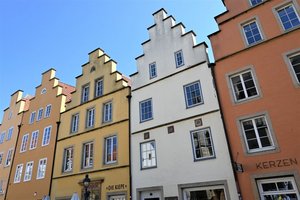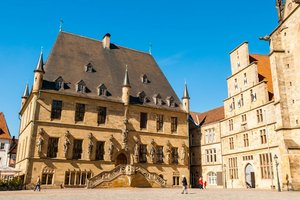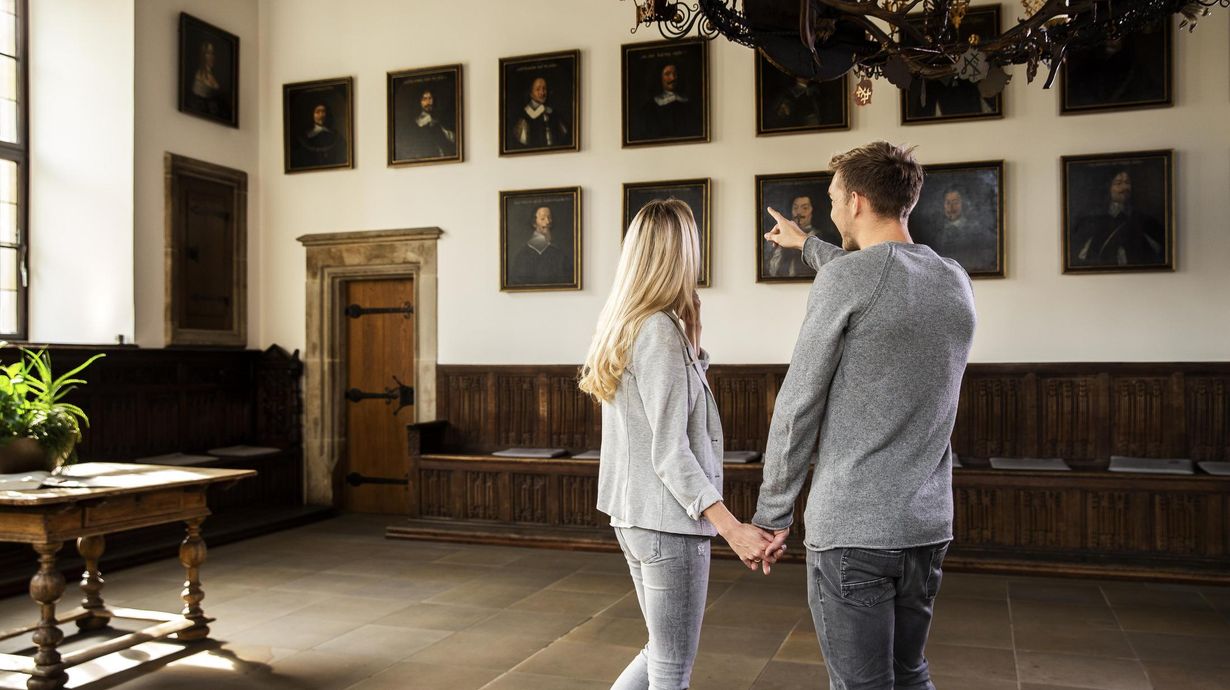The Chamber of Peace of the historic Town Hall in Osnabrück is one of two locations of the Peace of Westphalia. Along with Münster, the peace treaties ending the Thirty Years' War were signed here. This also ended the eighty-year war in the Netherlands that led to the country’s independence.
The Thirty Years' War
The Thirty Years' War began in 1618 with the Defenestration of Prague, originally as a religious conflict between Catholics and Protestants. However, it quickly expanded into a political and military conflict in the Holy Roman Empire of the German Nation and throughout Europe. An estimated six million people fell victim to looting, suffering, murder and destruction. In addition, there were epidemics and diseases, such as the plague in 1635. The consequences of economic decline and the loss of cultural development due to severe depopulation, among other things, strongly marked the post-war years. This extremely costly war involving heavy losses finally made the warring parties change their minds and work towards a diplomatic peace solution.
The Peace of Westphalia
Therefore, in 1643, the Peace Congress began in the two Westphalian cities of Münster and Osnabrück. The proximity of the two towns and their yet undestroyed infrastructure ensured not only a rapid exchange of information, but also accommodation and supply facilities for the envoys and their entourage. Osnabrück, which was predominantly Protestant, was chosen as the place of negotiation for the Swedes, the emperor's envoys and the Protestant imperial estates, while the envoys of France, the emperor and the Catholic imperial estates met in Catholic Münster. The protracted negotiations, which were often threatened with failure, were ceremoniously sealed in Osnabrück on 6 August 1648 between Sweden, the imperial estates and the Emperor with the so-called Osnabrück handshake. The peace treaties were signed in Münster on 24 October 1648, and the peace agreement was then proclaimed from the steps of Osnabrück's town hall on 25 October.
A record of diplomacy
The Peace of Westphalia is considered an outstanding event in German and European history because it laid the first foundations for a united Europe. Never before has a war been ended through diplomacy. Since April 2015, the Osnabrück Town Hall and the Münster Town Hall have therefore been awarded the European Heritage Label. The European Commission awards this label to places that have a special significance for the history of Europe.
The envoys' portraits
The walls of the Chamber of Peace in the Town Hall, completed in 1512, are adorned with portraits of 42 European envoys to the Peace Congress and portraits of the rulers of the warring parties at the time - Queen Christina of Sweden, King Louis XIV of France and the Roman-German Emperor Ferdinand III. The renowned Flemish painter Anselm van Hulle was commissioned to paint them in 1648. In 1886 they were almost replaced by large-format history paintings, as they no longer corresponded to contemporary taste. Below the portraits and windows are the oak pews decorated with carvings, which combine Gothic patterns with early Renaissance motifs.
The Privilege Shrines and the Chandelier
The so-called privilege shrines are set back into the masonry between the windows. As wall closets, they served, among other things, the large Osnabrück hospitals for the safekeeping of important documents such as deeds of endowment and prescriptions. They are decorated with figural and ornamental carvings by the Osnabrück master's workshop. The wall cupboards with plainer doors could be rented by citizens for their valuables as a kind of safe deposit box. As a central showpiece, a wrought-iron chandelier from the 16th century towers over the room. Its three levels depict paradise (in the form of Adam and Eve and the tree of knowledge), the firmament (the heavens) with sun, moon and stars, as well as Mary with the baby Jesus and three representatives of the estates (interpreted as the nourishing estate, the defence estate and the teaching estate). Naturalistically shaped lilies with volunte-like twisted candlesticks alternate on the hoop, interrupted only once by a round shield with the city's coat of arms. The thirty-six point reindeer antlers were added later. Queen Christina of Sweden presented it to the city of Osnabrück for the signing of the peace treaty.
The Chamber of Peace in the 20th century
In the course of time, the Peace Hall was repeatedly subjected to structural changes (a tiled stove, boarding up of the ceiling beams, whitewashing of the wall paintings). Fortunately, the inventory escaped the bombs of the Second World War through timely removal from storage, so that the Chamber of Peace could be ceremoniously reopened in 1948, on the occasion of the 300th anniversary of peace. In 1987, the parquet floor and the temporary coffered ceiling were replaced by today's sandstone tiles and ceiling beams made of 200-year-old river wood. In 1998, on the occasion of the 350th anniversary of the Peace of Westphalia, the Chamber of Peace was the venue for a ceremonial gathering of 20 queens, kings and heads of state of the former warring parties, including Queen Beatrix of the Netherlands, King Carl XVI Gustaf of Sweden, King Juan Carlos I of Spain and the then German President Roman Herzog. Visitors can sign the Golden Book, which is on display in the Chamber of Peace.
Tradition of the Handgiftentag Day
A special tradition is Handgiftentag, “handshake day”, which takes place every year on the day after New Year's Day in the Chamber of Peace. It goes back to a tradition in the Osnabrück city constitution, the "Sate", dating from 1348, when the electors for the council election joined hands as a sign of their honourable intentions. The citizens were called upon by the town clerk to go to the town hall on the day in question to elect the councilmen at the sound of the bell. Those not present were threatened with a fine. As soon as the election was completed,the neighbouring church of St. Mary's announced it with its bells. Even today, Handgiftentag day has a special significance. The Lord Mayor addresses future prospects, and all participants formulate their will to commit themselves to the town by joining hands.
Other sights of the Town Hall
In addition to the Chamber of Peace and a model of the city of Osnabrück from 1633, visitors can also see the treasury, where the council silver, coins, mint stamps, the oldest marksmen's chain and important documents are kept.
At a glance
| Opening times |
The town hall information desk is open Monday to Friday from 10 am to 5 pm.
The historic Osnabrück Town Hall is open for tourist visits from Monday to Friday from 10 am to 5 pm, on Saturdays from 9 am to 4 pm and on Sundays from 10 am to 4 pm. The town hall is not usually open on public holidays. |






